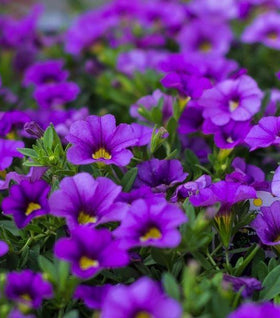Calibrachoas for Sale Online
Calibrachoa plants are the trendiest blooming annual flowers on the market today. Superbells look like small petunias when in flower. Calibrachoa flowers are often two-toned, with the outer edges being one color and the throats or centers being a different color or shade. Some flowers have a striped pattern like Calibrachoa Superbells Lemon Slice while others have complementary colors on each flower, such as Calibrachoa Superbells Blue Moon Punch.
Calibrachoa plants are often called million bells, and once you add them to your landscape, you'll soon see why. Calibrachoas are the stars of hanging baskets, mixed-container gardens, and window boxes. All of your plantings can be tied together to create a balanced and cohesive color scheme. Your porch pots can match your hanging baskets, window boxes, and even annual landscape plantings with these jewels.
Calibrachoa plants grow best in full sun in well-drained soil. They are very heat-tolerant and will continue to bloom all summer and well into fall if fertilized every few weeks. If your superbells start to get tired-looking, trim them back, and they will flush and become just as vigorous as the day they were planted.
How to Grow Calibrachoa Plants
In most growing zones, million bells are best planted in the spring. Calibrachoas will bloom continuously from spring until the first frost, and their flowers attract butterflies and hummingbirds. Million Bells are also fast-growing and quickly trails toward the ground as a "spiller" when grown in containers. Because of its trailing habit, it looks great in hanging baskets, bowls, or mixed containers.
Calibrachoas are considered a “self-cleaning” plant. This means they do not need to be deadheaded to keep blooming. They will however benefit from a trim towards the end of summer to keep them looking fresh and vibrant.
Are Calibrachoas Deer-Proof?
Deer have shown to be not very interested in Calibrachoa, although it is not classified as deer-resistant they do not seem to be bothered.
What is the best sunlight exposure for Calibrachoa plants?
Calibrachoa plants bloom best when given at least six hours of direct sun per day, but they can tolerate partial shade. Partial shade is good for million bells grown in warmer areas of the country. in warmer areas, plants that get some shade from the midday sun are likelier to survive through the summer months. Not enough sun exposure typically results in reduced blooming.
Watering Calibrachoas in Pots
Calibrachoa plants should be kept well watered but not soaking wet. Water only when the top inch or so of the soil dries out when growing in pots or containers. To check if your calibrachoa (or any plant) needs water, stick your finger into the soil up to your second knuckle. If the soil feels dry at your fingertip, water until water drains out of the bottom of the pot.
Heat, wind, and lack of humidity cause soil to dry out quickly. Depending on your conditions, you may have to water every day during periods of hot weather. Remember watering requirements may change as the summer heats up. Be careful not to overwater the plant, as this can encourage root rot.
Fertilizing Calibrachoa Plants
Calibrachoas are considered heavy feeders that should be fed with a slow-release fertilizer and/or a diluted liquid fertilizer regularly. Fertilizing is particularly important near the end of the season to promote fall blooms. Be mindful not to over-fertilize—follow the directions on the label of the fertilizer closely. Leaves that turn a light green or yellowish color are a sign that the plant needs fertilizer, or possibly even more sun.



